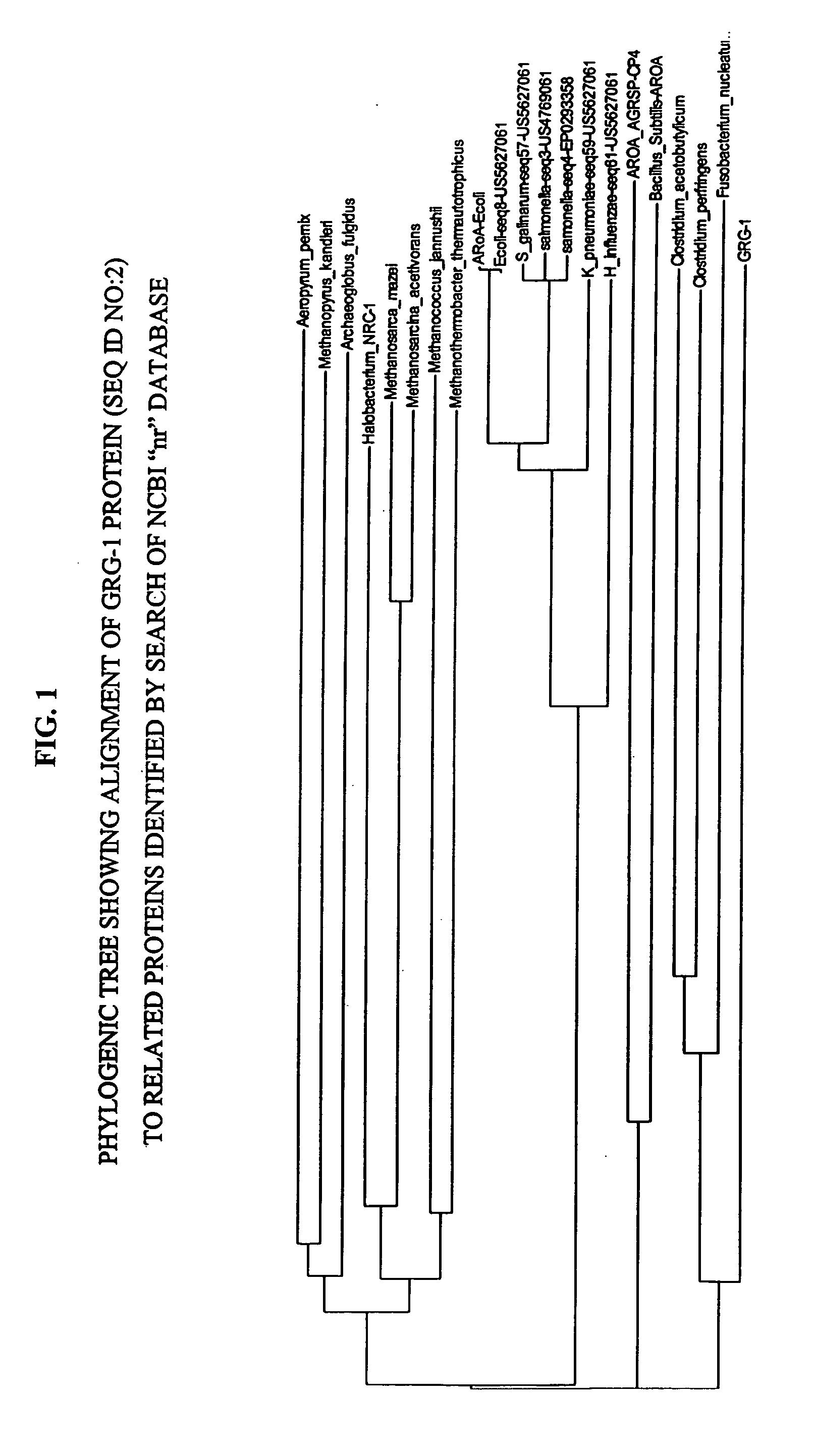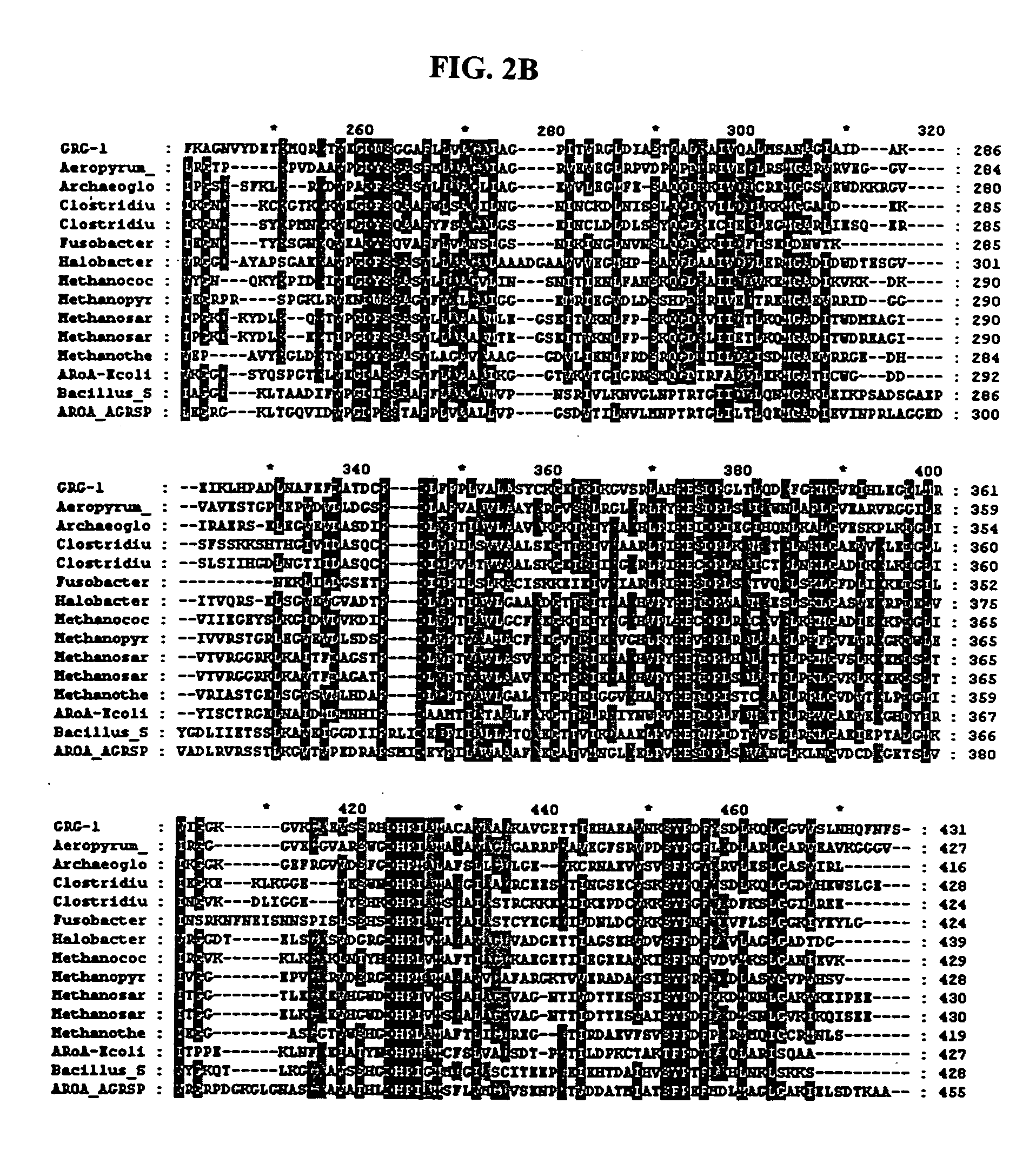Genes conferring herbicide resistance
a technology of herbicide resistance and gene, applied in the field of gene, can solve the problems of toxic to bacterial cells, not only to kill plant cells, but also to kill these bacteria,
- Summary
- Abstract
- Description
- Claims
- Application Information
AI Technical Summary
Benefits of technology
Problems solved by technology
Method used
Image
Examples
example 1
Isolation of Strains Resistant to Glyphosate
[0081] Glyphosate-resistant bacteria were isolated by plating samples of soil on Enriched Minimal Media (EMM) containing glyphosate as the sole source of phosphorus (EMM+G). Since EMM+G contains no aromatic amino acids, a strain must be resistant to glyphosate in order to grow on this media.
[0082] Enriched Minimal Media (EMM), per Liter
[0083] 10 g sucrose
[0084] 1 g NH.sub.4Cl
[0085] 0.2 g Mg.sub.2SO.sub.4 7H.sub.2O
[0086] 0.01 g FeSO.sub.4 7H.sub.2O
[0087] 0.007 g MnSO.sub.4 H.sub.2O
[0088] EMM+G
[0089] 80 ml EMM
[0090] 20 ml 50 mM glyphosate
[0091] -adjust pH to 8.5
[0092] One particular strain, designated ATX1398, was selected due to its ability to grow in the presence of high glyphosate concentrations. ATX1398 was isolated from a sample of mushrooms. Approximately one gram of sample was added to 10 ml of EMM+G and incubated overnight at 25.degree. C. 100 .mu.l of this culture was added to a fresh tube containing 1 ml of EMM+G and incubated over...
example 2
Construction of Cosmid Libraries
[0093] Strain ATX1398 was grown in EMM, and cells were pelleted by centrifugation. Genomic DNA was extracted from ATX1398, partially digested with the enzyme Sau3A I, ligated into a cosmid vector (Supercos 1 from Stratagene) and packaged into phage particles using techniques well known in the art. An aliquot of the phage was transfected into E. coli strain JM101 (a strain known to be sensitive to glyphosate) and plated on LB agar medium containing 50 .mu.g / ml kanamycin to select for colonies containing cosmids.
example 3
Isolation of Clones Conferring Glyphosate Resistance Upon E. coli
[0094] Approximately 700 kanamycin resistant colonies from genomic libraries of strain ATX1398 were replica plated onto LB-kanamycin agar, MOPS agar containing 50 .mu.g / ml kanamycin and 2 mM glyphosate, and MOPS agar containing 50 .mu.g / ml kanamycin and 5 mM glyphosate. Four clones grew in the presence of 2 mM glyphosate. Cosmid ATX1398(4) was observed to grow in the presence of 5 mM glyphosate. Cosmid DNA was purified from clone ATX1398(4) and retransformed into JM101 cells using standard techniques. All resulting colonies containing the intact cosmid were resistant to 5 mM glyphosate.
[0095] A second aliquot of packaged phage was transfected into JM101 cells and plated directly onto MOPS agar medium containing 50 mg / ml kanamycin and 2 mM glyphosate. Several glyphosate-resistant colonies were selected. One clone, cosmid ATX1398(11), was identified which conferred resistance. Restriction digest analysis of clone ATX1398...
PUM
| Property | Measurement | Unit |
|---|---|---|
| Fraction | aaaaa | aaaaa |
| Composition | aaaaa | aaaaa |
| Electrical resistance | aaaaa | aaaaa |
Abstract
Description
Claims
Application Information
 Login to View More
Login to View More - R&D
- Intellectual Property
- Life Sciences
- Materials
- Tech Scout
- Unparalleled Data Quality
- Higher Quality Content
- 60% Fewer Hallucinations
Browse by: Latest US Patents, China's latest patents, Technical Efficacy Thesaurus, Application Domain, Technology Topic, Popular Technical Reports.
© 2025 PatSnap. All rights reserved.Legal|Privacy policy|Modern Slavery Act Transparency Statement|Sitemap|About US| Contact US: help@patsnap.com



